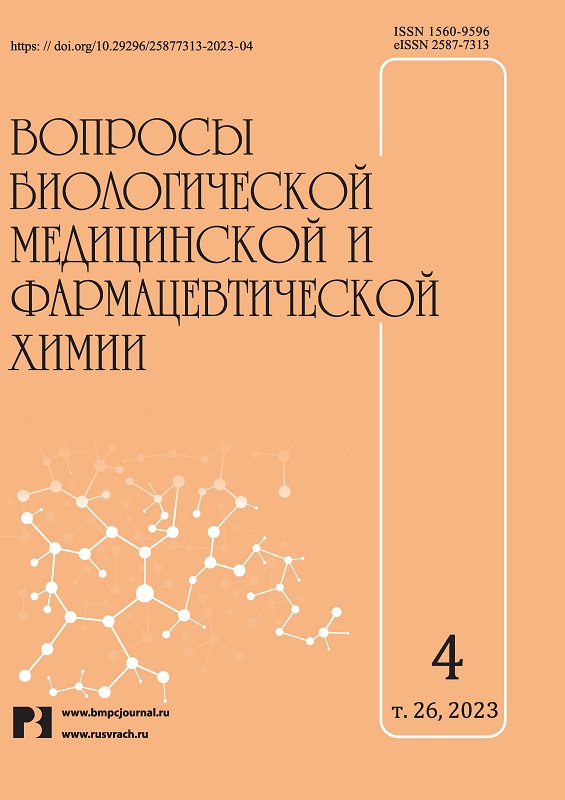Harmonization of determination by thin-layer chromatography of the main groups of bas in medicinal plant raw materials of the republic of Tajikistan with the requirements of the state budget of the Russian Federation XIV edition
- 作者: Sakhratov V.A.1, Malkova T.L.2, Uglovskaya A.S.2, Karpova L.N.2
-
隶属关系:
- Tajik National University
- Perm State Pharmaceutical Academy
- 期: 卷 26, 编号 4 (2023)
- 页面: 43-47
- 栏目: Pharmaceutical chemistry
- URL: https://journals.eco-vector.com/1560-9596/article/view/340941
- DOI: https://doi.org/10.29296/25877313-2023-04-07
- ID: 340941
如何引用文章
详细
Relevance. The quality of medicinal plant raw materials is a necessary condition for its suitability for use along with safety. The appearance of impurities or the loss of biologically active substances during improper harvesting and storage negatively affect the pharmacological and physico-chemical properties. The regulatory framework for the evaluation of medicinal plant raw materials (LRS) in the Republic of Tajikistan includes the use of the USSR State Pharmacopoeia (GF) of the 11th edition, in the articles of which there is no section for determining the main groups of biologically active substances (BAS). Currently, the State Budget of the Russian Federation XIV has established a methodological approach for determining the main groups of BAS by thin-layer chromatography (TLC), which is economical, express and can be recommended for use in routine analytical practice of chemical laboratories of the Republic of Tajikistan for the purposes of input control of raw materials. Therefore, it is extremely important to harmonize the methodological basis for assessing the quality of the LRS of the Republic of Tajikistan with the requirements of the State Budget of the Russian Federation XIV.
The purpose of the work is to introduce into analytical practice the methodology for determining biologically active substances in plant raw materials produced and/or sold in pharmacy institutions of the Republic of Tajikistan by harmonizing and improving the methods of the State Budget of the Russian Federation XIV.
Materials and methods. The objects of the study were motherwort grass (Leonurus spp.), horsetail (Equisetum arvense), nettle leaves (Urtica dioica), thyme grass (Thymus serpyllum), representing LRS in cardboard packs purchased in pharmacies of the Republic of Tajikistan. It was not possible to determine the origin of raw materials (wild or cultivated) in these objects. Plates for Sorbfil PTSH-P-V-UV thin-layer chromatography were used as the stationary phase. The conditions of sample preparation, chromatography, and interpretation of the results obtained were optimized taking into account the current pharmacopoeia articles of the State Budget of the Russian Federation XIV.
Results. The harmonization of methods for determining the main groups of BAS of horsetail grass, motherwort, thyme, nettle leaves growing in the Republic of Tajikistan by thin-layer chromatography was carried out. Methodological recommendations have been developed.
Conclusions. The thin-layer chromatography method, due to its accessibility, cost-effectiveness and low time spent on analysis, can be widely used in the Republic of Tajikistan for the purposes of input and sample control of raw materials.
全文:
作者简介
V. Sakhratov
Tajik National University
编辑信件的主要联系方式.
Email: kaftox1@mail.ru
Assistant, Department of Pharmaceutical Chemistry and UEF
塔吉克斯坦, DushanbeT. Malkova
Perm State Pharmaceutical Academy
Email: kaftox1@mail.ru
Dr.Sc. (Pharm.), Professor, Head of Department of Toxicological Chemistry
俄罗斯联邦, PermA. Uglovskaya
Perm State Pharmaceutical Academy
Email: kaftox1@mail.ru
Student
俄罗斯联邦, PermL. Karpova
Perm State Pharmaceutical Academy
Email: kaftox1@mail.ru
Ph.D. (Chem.), Senior Lecturer, Department of Toxicological Chemistry
俄罗斯联邦, Perm参考
- Gosudarstvennaja farmakopeja SSSR: Vyp. 2. Obshhie metody analiza. Lekarstvennoe rastitel'noe syr'e. MZ SSSR. 11-e izd. M.: Medicina, 1989; 400 s.
- Gosudarstvennaja farmakopeja Rossijskoj Federacii. Izdanie XIII. 2015. T. 3. [Jelektronnyj resurs]. Rezhim dostupa: https://docs.rucml.ru/feml/pharma/v13/vol3/ (da-ta obrashhenija 29.04.2022).
- FS.2.5.0019.15. Krapivy dvudomnoj list'ja. Gosudarstvennaja farmakopeja Rossijskoj Federacii. Izdanie XIV. 2018. T. 4. [Jelektronnyj resurs]. Rezhim dostupa: https://docs.rucml.ru/feml/pharma/v14/vol4/951/ (data ob-rashhenija 29.04.2022).
- FS.2.5.0034.15. Pustyrnika trava. Gosudarstvennaja farmakopeja Rossijskoj Federacii. Izdanie XIV. 2018. T. 4. [Jelektronnyj resurs]. Rezhim dostupa: https://docs. rucml.ru/feml/pharma/v14/vol4/1169/ (data obrashhenija 29.04.2022).
- FS.2.5.0045.15. Hvoshha polevogo trava. Gosudarstvennaja farmakopeja Rossijskoj Federacii. Izdanie XIV. 2018. T. 4. [Jelektronnyj resurs]. Rezhim dostupa: https://docs. rucml.ru/feml/pharma/v14/vol4/1357/ (data obrashhenija 29.04.2022).
- FS.2.5.0047.15. Chabreca trava. Gosudarstvennaja farmakopeja Rossijskoj Federacii. Izdanie XIV. 2018. T. 4. [Jelektronnyj resurs]. Rezhim dostupa: https://docs.rucml.ru/feml/phar-ma/v14/vol4/1375/ (data obrashhenija 29.04.2022).
- FS.2.5.0097.18. Tim'jana obyknovennogo trava. Gosudarstvennaja farmakopeja Rossijskoj Federacii. Izda-nie XIV. 2018. T. 4. [Jelektronnyj resurs]. Rezhim do-stupa: https://docs.rucml.ru/feml/pharma/v14/vol4/1287/ (data obrashhenija 29.04.2022).
- FS.2.5.0029.15. Mjaty perechnoj list'ja. Gosudarstven-naja farmakopeja Rossijskoj Federacii. Izdanie XIV. 2018. T. 4. [Jelektronnyj resurs]. Rezhim dostupa: https://docs. rucml.ru/feml/pharma/v14/vol4/1101/ (data obrashhenija 29.04.2022).
补充文件





